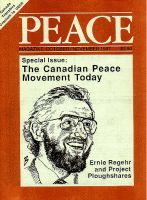
Peace Magazine Oct-Nov 1987, page 24. Some rights reserved.
Search for other articles by Sheena Lambert here
Two different campaigns are gearing up to win peace at the ballot box. We've asked the organizers to describe their respective plans. First, Sheena, the Campaign Coordinator for the Canadian Peace Alliance
The Canadian Peace Pledge Campaign, facilitated by the Canadian Peace Alliance (CPA), is the most ambitious project of the Canadian peace movement. Although it is an extraordinary challenge, it comes at an opportune time and it has a real chance of success. The Canadian public increasingly wants Canada to have its own international voice. This fact, combined with the sudden political debate that follows the White Paper's release and the NDP's response, has given the peace movement a matchless opportunity to make Canada's involvement in the arms race into a major federal election issue.
Peace groups and major national organizations met in Regina last March as the CPA Steering Committee hammered out the platform and confirmed a balanced, regionally representative system for decision-making. Since then, more than l00 organizations have become campaign sponsors. The Greater Victoria Disarmament Group has hired a coordinator to organize distribution and tabulation of the peace voter pledge cards. In Vancouver, EAR has collected more than 8,000 pledges. In Calgary, the committee includes church, women's, peace, labor, and youth representatives, with the support of the Alberta Federation of Labour and the Calgary labour Council. Committees have been struck in Toronto and Québec, and in the Atlantic provinces a pilot version of the campaign met with success in the St John's East by-election.
The campaign challenges us to link up and create a structure for political pressure within individual ridings by collecting "voter pledge cards." These state that individuals will choose only pro-peace politicians. The pressure will be increased through advertising, public debates and the circulation of a survey to pin down the positions of each candidate. Grassroots lobbying will be supplemented with nationally lobbying the three federal parties in Ottawa. The creation of this national riding-based structure will signal to politicians that the peace movement -- however diverse -- is united in its determination to make peace a vote-deciding issue in Canada.
The Canadian Peace Pledge Campaign is very like the New Zealand "Votes for Peace" campaign, which made Nuclear-Free New Zealand a key issue in the 1984 and 1987 elections. Both the Canadian Peace Pledge and the "Votes for Peace" campaigns use "voter pledge cards." Both rely on a nation-wide structure of riding committees. And both have as a principal goal making their countries nuclear-weapons free.
Judging also from polls over the last year, it should be possible to convince voters to cast their vote on the basis of a candidate's commitment to disarmament. According to a survey commissioned by External Affairs in August, the top concern of Canadian voters are: international peace and Canadian independence and control over its own affairs. Polls by Angus Reid and Goldfarb also show the majority of Canadians opposed to cruise testing, opposed to the purchase of nuclear submarines, and in favor of making Canada a nuclear weapons free zone.
Most Canadians support an end to Canada's participation in the arms race, bat feel unable to convince politicians. The campaign will give them a way of expressing this concern and their support for politicians who work for an independent Canadian voice for world peace.
Canadians face a greater challenge than New Zealanders in getting politicians to support a nuclear-weapons free policy. We are next door to the U.S. and economically and militarily bound to it much more than New Zealand. We have to show Canadians that the advantages to ending our involvement in the arms race far outweigh the disadvantage of rattling our relations with the U.S. The White Paper will actually help us do so.
The White Paper is fuel for the Peace Pledge Campaign. The last two years, Canadian peace activists have uneasily felt they were boxing at shadows. It was difficult building public opposition to SDA 2000, for instance, when so few people were clear about what it was. It was difficult to create grassroots resistance to building up the North Warning System, when the distinction was so obscure between active air defences and passive surveillance and when the government had not specified just which of the two it intended for Canada.
But now the Government has saved us the immense trouble of tracking down its position. It has spelled out a policy so awful, so grossly shortsighted, and so obviously backward in terms of its cold war rhetoric, that, once it has been fully exposed, it will likely be rejected by average Canadians.
After the White Paper and the NDP's response, Canadians are seeking to define Canada's defence and foreign policy. The role of the Canadian Peace Pledge Campaign -- beyond opposing the White Paper and Canadian involvement in the nuclear arms case -- is to provide a vision of Canada as a peacemaker.
The Canadian Peace Pledge Campaign shows voters that, through the political process, and using practical grassroots methods, they can influence the nuclear policies of their government. It shows Canadian politicians that their support for peace could determine whether they get elected. To become involved in the campaign, contact the CPA office, Suite 5, 555 Bloor St W., Toronto, Ontario MSS 1Y6. Phone: 4l16-588-5555.

Peace Magazine Oct-Nov 1987, page 24. Some rights reserved.
Search for other articles by Sheena Lambert here